obj = SPLINE/[CLOSED,]{point[,{VECT,dx,dy,dz|TANTO,curve|angle}]}+
Spline allows you to create a spline through a series of previously defined points. The resulting spline is generated by cubic (third order) polynomials. The optional minor word CLOSED causes the first point to be automatically assumed as the last point and the spline to be closed. In a closed spline, the starting slope is forced to be equal to the slope at the ending point. If the CLOSED minor word is omitted, the spline is open even if the first and last points are coincident and the starting and ending slopes are not forced to be the same.
A maximum of 102 arguments may be stated in the spline definition. If each knot point, for example, has an associated vector, tangency point, or angle, only 51 knot points could be used in the statement. Subranges can be used to exceed this limitation.
The format below shows the series of options (except the minor word CLOSED) which are repeated for each point in the spline. At least two points must be specified.
Using the Approximate Curves method creates a spline which approximates a list of previously defined objects. The spline can be created to a tolerance, or by approximating each spline segment for each object in the list.
|
Parameter |
Description |
|
CLOSED |
Minor word that indicates that the spline is closed on itself whether or not the first and last points are coincidental. The beginning and ending of the spline is also tangent at the first point. |
|
point |
An object list or array which represents a series of previously defined points that the spline passes through. |
![]() NOTE: The following parameters represent various ways of
controlling the slope of the spline at each point in the object list/array.
Several slopes can be specified and are matched with points in order beginning
with the first point in the object list.
NOTE: The following parameters represent various ways of
controlling the slope of the spline at each point in the object list/array.
Several slopes can be specified and are matched with points in order beginning
with the first point in the object list.
You can repeat point and tangent specifications as many times as needed in a single statement (up to 102 arguments). You can specify more points than tangents parameters.
|
VECT |
Minor word that indicates that the slope of the spline at the previous point is to be defined as a Vector by the values in the next three fields. |
|
dx,dy,dz |
Three work coordinate values which represent the components of the slope vector. |
|
TANTO |
Minor word that indicates that the slope of the spline at the previous point is to be defined as being tangent to a specified curve. |
|
curve |
A previously defined object which is used to define the slope of the spline. |
|
angle |
Numerical value which defines the slope of the spline at the previous point in degrees measured counterclockwise from the positive X Axis. |
![]() NOTE: Definition of the slope of the spline can be performed in
any one of the three mutually exclusive manners above. You may mix the methods
in any SPLINE statement as long as you use only one method for any one
point.
NOTE: Definition of the slope of the spline can be performed in
any one of the three mutually exclusive manners above. You may mix the methods
in any SPLINE statement as long as you use only one method for any one
point.
Creating a spline with no slope controls specified. In this case, the spline is fit through the points as smoothly as possible. An open and closed splines are created with the same points.
Declarations
ENTITY/P(4),SPLN(2)
Geometry Definition
P(1)=POINT/-1,0
P(2)=POINT/0,0
P(3)=POINT/1,.866
P(4)=POINT/2,.75
Spline Definition
SPLN(1)=SPLINE/P
SPLN(2)=SPLINE/CLOSED,P
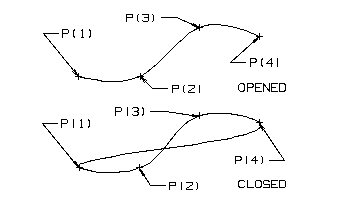
An Open and Closed Spline through the Same Points
Creating a spline with no slope controls specified. In this case, the spline is fit through the points as smoothly as possible. Open and closed splines are created with the same points.
Declarations
ENTITY/P(4),SPLN(2)
Geometry Definition
P(1)=POINT/0,0
P(2)=POINT/1,-1
P(3)=POINT/2,0
P(4)=POINT/1,1
Spline Definition
SPLN(1)=SPLINE/P,P(1)
SPLN(2)=SPLINE/CLOSED,P
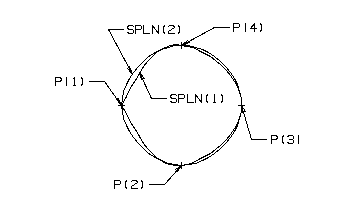
A Closed and Open Spline Where the End Points Are Coincident
Creating a spline using the minor word VECT followed by the three component values of the desired vector. The spline, at this point, is tangent to the specified vector.
Declarations
ENTITY/P(5),SPLN1
Geometry Definition
P(1) =POINT/-1,0
P(2)=POINT/0,0
P(3)=POINT/1,.866
P(4)=POINT/2,.75
P(5) =POINT/3,1.5
Spline Definition
SPLN1=SPLINE/P(1),P(2),VECT,1,2,0,P(3),P(4),$
VECT,-1,-2,0,P(5)
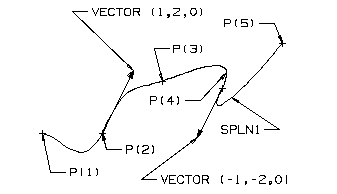
A Spline Constrained by Vectors
Creating a spline using the minor word TANTO and an existing curve. The curve tangent of the spline, at this point, is parallel to the curve tangent of the specified curve at its closest end point.
Declarations
ENTITY/CR(3),P(3),SPLN1
Geometry Definition
CR(1)=CIRCLE/-2,0,.5,START,270,END,330 CR(2)=CIRCLE/0,1,.5,START,180,END,270 CR(3)=CIRCLE/1.5,0,.5,START,180,END,270
P(1)=POINT/-1,-1
P(2)=POINT/0,0
P(3) =POINT/1,-1
Spline Definition
SPLN1=SPLINE/P(1),TANTO,CR(1),P(2),TANTO,CR(2),$
P(3),TANTO,CR(3)
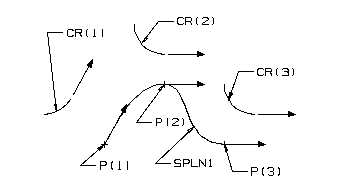
A Spline Constrained by Curves and Vectors
Creating a spline by specifying an angle at which the spline is to be tangent. The angle is measured with respect to the X axis of the work coordinate system.
Declarations
ENTITY/P(4),SPLN1
Geometry Definition
P(1)=POINT/-1,0
P(2)=POINT/0,0
P(3)=POINT/1,.866
P(4)=POINT/2,.75
Spline Definition
SPLN1=SPLINE/P(1),90,P(2),300,P(3),90,P(4),300
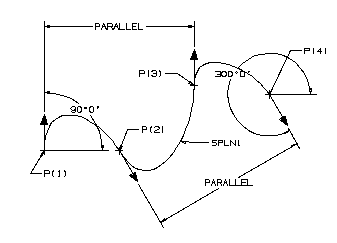
A Spline Constrained by Angles
Demonstrates the use of subrange operators to exceed the knot point limitations in the SPLINE command. This example demonstrates that the statement
SPLINE/P(1..9),VECT,V(1..6),P(10..11),A(5..6)
is equivalent to
SPLINE/P(1),VECT,V(1),V(2),V(3), $
P(2),VECT,V(4),V(5),V(6), $
P(3),P(4),P(5),P(6),P(7),P(8),P(9), $
P(10),A(5),P(11),A(6)
The following statement found at the end of the program demonstrates how to avoid exceeding the maximum of 102 arguments.
SPL3=SPLINE/P(1..500),VECT, V(1..1500),P(501..1000),A(1..500)
Declarations
ENTITY/P(1000),SPL1,SPL2,SPL3
NUMBER/V(1500),A(500),I,J
&ENTCLR = &RED
J = 1
DO/L1:,I,1,1000
P(I) = POINT/I,J,-J
IF/J==1,JUMP/ELSE1:
J = 1
JUMP/END1:
ELSE1:
J=-1
END1:
L1:
DO/L2:,I,1,500
V(I*3-2) = -1.0
V(I*3-1) = 0.0
V(I*3) = 0.0
L2:
DO/L3:,I,1,500
A(I) = 180.0
L3:
SPL1 = SPLINE/P(1),VECT,V(1),V(2),V(3), $
P(2),VECT,V(4),V(5),V(6), $
P(3),P(4),P(5),P(6),P(7),P(8),P(9), $
P(10),A(5),P(11),A(6)
MESSG/'SPLINE #1'
&ENTCLR = &CYAN
SPL2 = SPLINE/P(1..9),V(1..6),P(10..11),A(5..6)
MESSG/'COMPARE SPLINE #2'
BLANK/SPL1,SPL2
$$
&ENTCLR = &YELLOW
SPL3 = SPLINE/P(1..500),VECT, V(1..1500),P(501..1000),A(1..500)
HALT